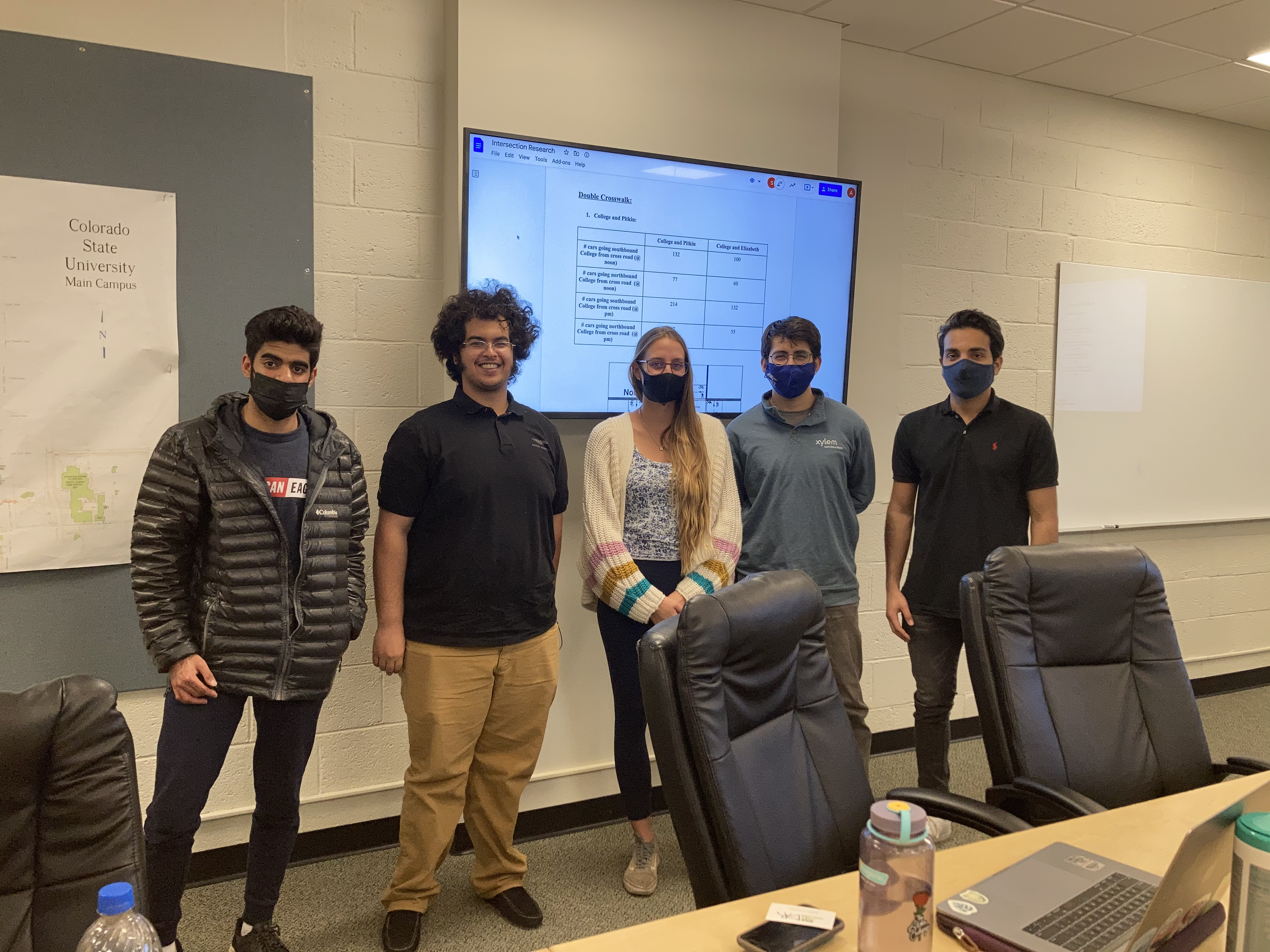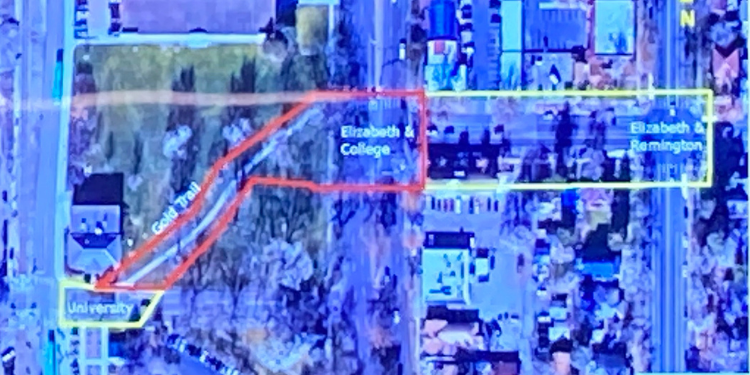 Bike Fort Collins was excited to hear that a group of CSU Engineering students selected the intersection of Elizabeth Street and College Avenue for a class project this fall. Recognizing the same problem that BFC brought to the attention of the City’s Bicycle Advisory Committee (BAC) and Transportation Board via a presentation in a joint meeting with both groups this past February, as well surveyed the community on and presented the results in our March Pedal Post e-Newsletter, their charge was to explore potential design solutions for the intersection this past semester.
Bike Fort Collins was excited to hear that a group of CSU Engineering students selected the intersection of Elizabeth Street and College Avenue for a class project this fall. Recognizing the same problem that BFC brought to the attention of the City’s Bicycle Advisory Committee (BAC) and Transportation Board via a presentation in a joint meeting with both groups this past February, as well surveyed the community on and presented the results in our March Pedal Post e-Newsletter, their charge was to explore potential design solutions for the intersection this past semester.
 BFC has been proud to serve on an Advisory Committee for this student project along with representatives from CDOT Region 4 (since they own College Avenue, which is also Highway 287 at this intersection) and CSU’s Parking and Transportation Services, Landscape Architecture, and Engineering and Capital Construction teams. Team DeWulff, which is what they named their fictitious consulting firm and is comprised of Albert Marquez (Team Lead), Anne Cushnie, Salim Al Abri, Jaber Al Sabah, Saud Al Amri and Daniel Norman, presented three well thought out design considerations to the Advisory Committee this week (December 8) to cap off this semester’s work.
BFC has been proud to serve on an Advisory Committee for this student project along with representatives from CDOT Region 4 (since they own College Avenue, which is also Highway 287 at this intersection) and CSU’s Parking and Transportation Services, Landscape Architecture, and Engineering and Capital Construction teams. Team DeWulff, which is what they named their fictitious consulting firm and is comprised of Albert Marquez (Team Lead), Anne Cushnie, Salim Al Abri, Jaber Al Sabah, Saud Al Amri and Daniel Norman, presented three well thought out design considerations to the Advisory Committee this week (December 8) to cap off this semester’s work.
This picture (below) outlines the boundary of the area they focused on for improvement, which not only includes the Elizabeth & College intersection, but also the intersection at Remington & Elizabeth, as well as CSU’s Gold Trail that connects the west side of the intersection up to the University Avenue & Mason Trail intersection.
 The main problem at Elizabeth & College is for bicyclists leaving campus and wanting to travel eastbound on Elizabeth. The Gold Trail on the campus side has cyclists and pedestrians cross College on the north side of Elizabeth, yet a bicyclist ultimately needs to be on the south side of Elizabeth to pick up the bike lane. Rather than cross College Ave. at the existing crosswalk, and then also cross Elizabeth (on the east side of College) via the existing crosswalk to get to the south side of the street (which is also referred to as a Dutch crossing, and is time consuming) the intersection elicits dangerous and potentially conflicting movements by cyclists by either crossing diagonally over College Ave. to get to the south side of Elizabeth, or crossing College at the crosswalk, and then diagonally crossing mid-block along East Elizabeth to get to the south side by the time they hit the Remington & Elizabeth intersection (see videos below showcasing both behaviors).
The main problem at Elizabeth & College is for bicyclists leaving campus and wanting to travel eastbound on Elizabeth. The Gold Trail on the campus side has cyclists and pedestrians cross College on the north side of Elizabeth, yet a bicyclist ultimately needs to be on the south side of Elizabeth to pick up the bike lane. Rather than cross College Ave. at the existing crosswalk, and then also cross Elizabeth (on the east side of College) via the existing crosswalk to get to the south side of the street (which is also referred to as a Dutch crossing, and is time consuming) the intersection elicits dangerous and potentially conflicting movements by cyclists by either crossing diagonally over College Ave. to get to the south side of Elizabeth, or crossing College at the crosswalk, and then diagonally crossing mid-block along East Elizabeth to get to the south side by the time they hit the Remington & Elizabeth intersection (see videos below showcasing both behaviors).
Given this, up for consideration by DeWulff were the following three design options. In each option reconfiguration of the Gold Trail to either split it, or make it wider to better accommodate both bicycle and pedestrian traffic was included:
DEWULFF DESIGN CONSIDERATIONS
- Option #1: Relocate where the Gold Trail meets College Ave. to align with the center of the intersection and create two diagonal crossings going eastbound: one to the north side of Elizabeth, and a second to the south side of the street.
- Option #2: Reconfigure the Gold Trail by splitting it, adding a spur that connects to a to-be-added crossing of College Ave. on the south side of Elizabeth, which would naturally be the way eastbound Elizabeth bicycle traffic would subsequently travel.
- Option #3: Keep the current crossing in place while reconfiguring the Gold Trail to be a wider multi-use path, and then installing a two-way cycle path on the north side of Elizabeth between College Ave. and Remington Street. The intersection of Remington and Elizabeth would then be reconfigured with a roundabout as a facility to allow eastbound bicycle traffic to safely get to the south side of Elizabeth to travel east of Remington.
DeWulff applied a fairly robust decision matrix to each option and ultimately recommended Option #2 as the most viable option, to which the Advisory Committee agreed. So now, next semester (spring 2022) they will endeavor to generate a formal design for Option #2. Stay tuned, as we’ll be sure to share.
In the meantime, great job to the DeWulff team and special thanks to CSU for including BFC in this process.
